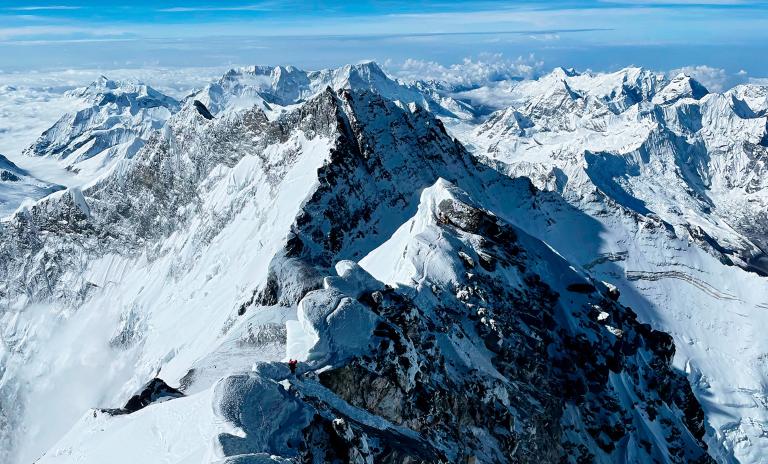Performance: Faster, Higher, Stronger
![{[downloads[language].preview]}](https://www.rolandberger.com/publications/publication_image/ta40_en_cover_3_download_preview.jpg)
Think:Act explores all factors related to performance for individuals and teams, with insights into metrics, AI, experimentation and authentic leadership.



by Steffan Heuer
Photos by Getty Images, AFP, Lakpa Sherpa, Alison Levine, Laurie Bagley, Garrett Madison, Scott Woolums
Read more on the topic “Performance”
Climbing Mount Everest, the world's highest peak, is something only a few will accomplish. Surviving a round trip through the "death zone" doesn't just make for a riveting story, though. It can also serve as a guide for leaders and teams to successfully scale their own mountains.
Clawing your way up an icefall and climbing the corporate rungs of an investment bank have a lot in common. Just ask extreme mountaineer Alison Levine, who worked at Goldman Sachs before making her way up Mount Everest in May 2002. As captain of an all-women team, she came within a few hundred feet of the summit but had to turn around due to a storm.

"No business executive is ever going to say that complacency is a good thing."
As she likes to tell it, the experience of almost standing on the world's highest peak makes for interesting reception conversations. Take the banker who asked her what she did and then commented: "Oh, so you didn't climb Mount Everest." Her question to him: "What do you do?" "I work at J.P. Morgan." "You are the CEO?" "No," her counterpart demurred. "Fixed income trading." To which Levine shot back: "Then you don't work for J.P. Morgan, really, do you?"
It's feisty vignettes like these that have made her a sought-after speaker at conferences, company gatherings and adjunct faculty at the West Point Military Academy – especially since she did finally make it to the summit of Everest in 2010. Levine makes a convincing argument why the hard lessons she learned while climbing the Seven Summits – or the highest peaks on each continent – and skiing to both Poles are not just thrilling tales of hardship and adventure, but apply to the business world as well, laying out how to become an effective leader, forge a team that doesn't crack and above all remain adaptable enough to reach seemingly unattainable goals. As Levine says: "No business executive is ever going to say that complacency is a good thing, that building relationships is not important, that clarifying goals is not important, that keeping your people out of harm's way is not important."
Levine is not alone in preaching about the intrinsic value of preparing for a daunting climb. Her 2014 book On the Edge was preceded in 2010 by Summit! by Laurie Bagley, who also turned her Everest slog into a resource that's highly relevant at sea level. Taken together, both books define the skill set, mindset and packing list of processes and gear to make it up and down alive, providing a toolkit to conquer any imaginary mountain that leaders and organizations set their sights on.
In the business world, it might be called a roadmap or go-to-market strategy. For climbers like Laurie Bagley and Alison Levine, getting ready for Everest was a yearslong process that involved a lot more than just physical preparation. Much more important than training climbs in extreme environments, lugging weights around or going days with little food or sleep was what Bagley calls a "mental packing list." As she explains, "you have to be really clear on why you want to do something. Your purpose will start creating the attraction that draws resources, people, ideas." Next comes assembling a team of mentors and advisors. Equally crucial is taking an honest inventory of your skills, "the ones that you need to have mastered or will be called upon to demonstrate." Bagley credits introspection and addressing shortcomings early on with giving her the courage to take five more steps because she felt she had it in her. "It was that five more steps that took me all the way to the summit."
Whether you're aiming for the top of Mount Everest or your own field, reaching a big dream requires the right tools.
1. Define the big Why to center your purpose and attract people, ideas and resources.
2. Seek out mentors and coaches.
3. Honestly assess your skills and address deficiencies.
4. Pick your mantra and keep it with you.
5. Assemble a team based on experience, expertise and ego.
6. Build a network that goes beyond your inner circle.
7. Realize that progress will sometimes mean going backward.
8. Define your red flags to know when to turn around.
9. Don't push the river and waste time and effort.
10. Consider your failures as lessons for the next attempt.
Climbers, not unlike executives, have big egos. Yet contrary to common management wisdom, those are exactly the people you want on your team, argues Levine, who also serves on the board of the Coach K Center on Leadership & Ethics at Duke University. When picking your team, Levine writes, "you want people who are good and who know they are good – because that gives them the confidence to know they can win." She distinguishes between performance ego or justified confidence and team ego or the pride to be part of something. "Timing, proximity, and a common goal are not enough to form a cohesive team."
A vital network effect is also something to be reckoned with. To make it out of a towering challenge alive, you need to make connections beyond your immediate circle of climbers or colleagues. That's why Levine makes it a habit to introduce herself to everybody in a camp, including total strangers, long before the ascent starts. Having met someone face to face, she reasons, increases the chance of her not being left to die somewhere on the mountain while another group trudges past. It's about "taking the time to connect with people at every stage of your career, people who will support you and maybe even save your life."
There are many routes to the goal, but one thing is certain for Mount Everest: Climbers like Levine, who took the southern approach via Nepal, and Bagley, who opted for the less crowded northern approach via Tibet, mostly climb up to come right back down. Acclimation around the so-called "death zone" above 8,000 meters demands that you advance to higher camps in intervals only to return to lower altitudes to survive and regain strength.
Backing up to stay strong or to avoid hazardous weather is different from backing down, as Levine has stressed in talks over and over again. "It's challenging and psychologically super frustrating," she admitted at an appearance at Google headquarters. "You are going backward but still making progress. Progress doesn't happen in one particular direction. Backtracking is not losing ground: It's an opportunity to regroup so you are better next time."
Bagley sees it as a game of patience that applies to every project. "Climbing Everest is a two-month commitment, going up and down and hoping for a window of four or five days of good weather to make a summit attempt. That experience taught me to wait. If you don't take shortcuts, if you do the work and have all skills in place, chances are it's going to happen, just not in the time frame you had in mind. That's when it helps to have a high-altitude mission and vision statement. In order to cope with the wait, the repetitive and exhausting schedule and the mental stress, both women kept mantras. "A mantra helps you visualize where you want to go and lets you simplify things," Bagley says.
In the end, a window of good weather opened up for both mountaineers. Yet standing on the top of the world was eerily anticlimactic, Levine says. "I thought, this is it? It doesn't change anything. It's the journey and what you learn to be better going forward." There also isn't much time to savor the moment beyond the obligatory photo. The clock is ticking during the eight- to ten-hour struggle to reach the summit, and coming down again is the most dangerous part of the whole endeavor, as exhaustion, brain fog and a false sense of accomplishment combine for an often-fatal mix. Since the first successful ascent in 1953, at least 310 people have died on Everest, most of them on the descent.
"You have to define the warning signs and watch for them. I have my three red flags."
The name of the game is not slipping up. "You have to define the warning signs and watch for them," explains Bagley. She called hers the "three red flags," shorthand for events that could potentially be life-threatening. Only if she was able to resolve such a problem quickly enough, would she push on, as when she got her boots and crampons entangled in old ropes on a ladder at the second step, a notoriously steep rock wall at 8,610 m. "I couldn't bend over to untangle the ropes from my feet. I knew if I took one misstep at this point it was a 10,000-foot drop off the side of the mountain." With her sherpa already over the ledge and out of sight, Bagley says she managed to calm herself down and tried to breathe normally to conserve oxygen, while waiting for the next climber behind her to eventually catch up and free her.
This mishap was a red flag that solved itself. "With every project, there will be outcomes we didn't want. The difference is knowing whether you are persevering and overcoming adversity or if you are pushing the river," she says, referring to the futile attempt at solving a problem that's beyond one's control.
Reacclimating to normal life is a descent in and of itself that can require taking some time to reflect and reevaluate. "It's a bizarre shift. You've achieved this massive goal that was years in the making, and then all of a sudden, you're back at your desk," Levine summarizes the blues that befell her after each expedition. Yet that feeling ought to be channeled into the next undertaking, she argues: "If you're thinking something can't be topped, you need to adjust your mindset. There is always something more, something different. There is always something that will make you stretch and grow, you just have to think big."
While Bagley has since decided to retire from mountaineering, it hasn't changed her approach to tackling tough goals. "Whatever comes next, there's always the initial Why," she says. "Whether you tell people you're training for Everest or work in a company, others sometimes feel threatened by a big dream. I'm not saying this won't affect you, but with purpose, it won't stop you."

![{[downloads[language].preview]}](https://www.rolandberger.com/publications/publication_image/ta40_en_cover_3_download_preview.jpg)
Think:Act explores all factors related to performance for individuals and teams, with insights into metrics, AI, experimentation and authentic leadership.
